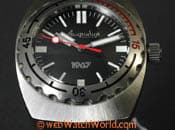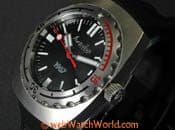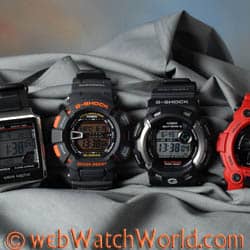Summary: The Vostok 1967 Amphibia is a beautiful and superbly made wristwatch that commemorates 40 years of the original Amphibia. Don’t confuse this watch with the Vostok Amphibia (review); the basic $60.00 Amphibia is a nice watch, but there’s no comparison in terms of quality, looks and materials. The 1967 Amphibia costs around $300 but looks like it’s worth 4-5 times as much.
Background

The Vostok 1967 Amphibia shown in these photos was announced in 2007 to commemorate the original Vostok Amphibia watches with this case style.
The originals are very much sought after by Russian watch collectors and they’ve been increasing in value (relatively speaking).
While many watch companies at all price levels are jumping on the “retro bandwagon”, too many wristwatches are trying to cash in on the fad by cribbing a retro appearance with a made-up history.
This, my friends, is the real thing!
 The 1967 Amphibia case shape, construction type and movement all have a long history, so there’s no need for a marketing department psuedo-heritage for this watch.
The 1967 Amphibia case shape, construction type and movement all have a long history, so there’s no need for a marketing department psuedo-heritage for this watch.
The original idea was for Vostok to make 1,967 of these “limited edition” wristwatches.
This one is number 1684, inscribed on the back. The demand was very high, even with the $60 Vostok Amphibia owners who balked (and still do) at the original $230.00 or so (and then rising over time to $295.00 and now $305.00) asking price of the 1967 commemorative.
When the first 1,967 were sold out, all of a sudden the prices of used examples started escalating and, as will sometimes happen with something you can’t get, interest rose. This must have been enough to persuade Vostok to re-establish the production line and the 1967 Amphibia is now readily available, albeit without the cachet, so to speak, of the original production run.
Versions of the Vostok 1967 Amphibia
 There are two versions of the 1967 Amphibia. The wristwatch shown here is the non-numbered version, with indices only on the face and a rubber strap. Another version is available; it has numbers at 12, 3, 6 and 9 o’clock positions and it also comes with a stainless steel bracelet.
There are two versions of the 1967 Amphibia. The wristwatch shown here is the non-numbered version, with indices only on the face and a rubber strap. Another version is available; it has numbers at 12, 3, 6 and 9 o’clock positions and it also comes with a stainless steel bracelet.
I like the non-numbered version better, because I think it has a cleaner look. This watch is very easy to read and it has beautiful and classic hour, minute and seconds hands.
Some owners don’t seem to like the rubber strap, but I think it is very high quality and definitely the best rubber strap I have ever seen on a watch (although I can’t claim to have seen every watch with this type of strap!).
 As usually happens, when I first saw the photos of the 1967 Amphibia, I had no idea what the strap would really look like in reality. I’ve been disappointed with the straps that have come on every Russian watch I ever bought, to a point where I just assume that I’ll be buying and fitting a new strap as part of the purchase.
As usually happens, when I first saw the photos of the 1967 Amphibia, I had no idea what the strap would really look like in reality. I’ve been disappointed with the straps that have come on every Russian watch I ever bought, to a point where I just assume that I’ll be buying and fitting a new strap as part of the purchase.
This is especially the case in the $60.00 version of the Amphibia; the bracelets that come with those are absolute junk, in my opinion. As soon as the watch arrives, I take it out of the box, remove the bracelet and throw it in the trash.
I have often wondered why the watch manufacturer — who specializes in producing watches, not straps — doesn’t partner with a strap maker or retailer to offer the customer a choice right from the factory. Charge a bit more for an optional strap or bracelet and — why not? — turn it into a profit center. I guess this style of think-new-think-different capitalism has yet to hit the Vostok factory (and many others!).
 In any case, the rubber strap on the 1967 Amphibian is leagues better than anything I’ve ever seen on any Russian watch for sure, and it’s better even than the rubber straps that came with two different multi-thousand dollar Glycine watches I once owned.
In any case, the rubber strap on the 1967 Amphibian is leagues better than anything I’ve ever seen on any Russian watch for sure, and it’s better even than the rubber straps that came with two different multi-thousand dollar Glycine watches I once owned.
As nice as the rubber strap is — and I do prefer the look of the non-numbered 1967 Amphibia on rubber — I have to admit, the bracelet is a gem. I was very fortunate to have been able to buy a used/new bracelet from an owner of a 1967 Amphibia numbered version, who did not want the bracelet and immediately removed it from his watch.
The bracelet is solid stainless steel, with solid machined end links, a standard dive clasp and extension and all the adjustments necessary and typical on a high-quality bracelet. You can see photos of the bracelet below and also in the video included below.
The only problem with the rubber strap is it is very long — too long I think. I have a 7-1/4″ circumference wrist and I have to wear the strap on the tightest setting hole. Fortunately, the double clasp and the thick rubber keeper do a good job at securing the extra length, but it would be nice to have more options.
Some owners have put their 1967 on a mesh bracelet, and it looks great in photos — I may try it myself one day.
Features of the Vostok 1967 Amphibia
 The thick stainless steel “cushion” style case of the 1967 Amphibia is a classic. It is beautifully finished on the commemorative, with polished sides nicely offsetting the brushed top surface, with its brush lines radiating outwards like a sunburst, catching the light.
The thick stainless steel “cushion” style case of the 1967 Amphibia is a classic. It is beautifully finished on the commemorative, with polished sides nicely offsetting the brushed top surface, with its brush lines radiating outwards like a sunburst, catching the light.
The case itself measures 6 mm thick and the total thickness of the watch, from the domed crystal to the slightly protruding case back, measures 15.55 mm on my Vernier dial caliper. The width is 42 mm (46 mm with the crown) and the distance from the top (12 o’clock) to the bottom (6 o’clock) of the case is 50.5 mm. The watch with rubber strap weighs a reasonable 118 grams.
The 1967 Amphibia wears very nicely on my wrist, with a presence that is larger than most 42 mm wristwatches but without looking ridiculous, as some of the 44+ mm, 15+ mm thick dive watches do nowadays.
 The face is very easy to read, despite the domed (mineral) crystal, which is not coated with an anti-reflective and which catches glints of light from any direction, as is illustrated in the photos and video! The indices are very carefully applied and the raised “Amphibia” logo in Cyrillic is superbly done also.
The face is very easy to read, despite the domed (mineral) crystal, which is not coated with an anti-reflective and which catches glints of light from any direction, as is illustrated in the photos and video! The indices are very carefully applied and the raised “Amphibia” logo in Cyrillic is superbly done also.
The watch does not have lugs in the classic sense. The 22 mm strap secures with the common springbars underneath the case and the edges of the strap are very nicely hidden under the case.
The bezel is uni-directional, with 90 firm clicks. It has a sort of muted sound, so either the thick case is masking some of the sound or there may be a nylon toothed arrangement underneath. I have not removed the bezel to find out. The bezel is not easy to turn, due to its curved top and thin serrated edges, but it looks great. And since this is more of a showpiece “desk diver” than the real thing (although it’s rated to 200 m), that’s not a problem.
The bezel is stainless steel and has nicely engraved and painted indices and numbers. It is very good looking and made with high quality, quite unlike the bezel on the basic Amphibia (see my article on how to replace the bezel on those).
Vostok 1967 Amphibia Movement
 The 1967 Amphibia uses the 2415 movement variant of the famed Vostok 2416 family. The 2415 is basically the 2416b but without a date function. I have not taken off the case back on this watch, so I don’t have photos.
The 1967 Amphibia uses the 2415 movement variant of the famed Vostok 2416 family. The 2415 is basically the 2416b but without a date function. I have not taken off the case back on this watch, so I don’t have photos.
My 1967 extremely accurate; probably the most accurate watch I own. It never varies more than 2 seconds in 24 hours when I set it to the NIST “Atomic” time. I have had very good luck with all of the Vostok 2416 family movements with regards to accuracy and this sturdy and robust “in house” movement is well regarded by watch collectors of all types.
It has the “poor man’s hack” feature, which allows the seconds hand to be held back with slight backwards pressure on the crown, as long as the watch isn’t fully wound. This allows accurate setting and it’s actually my preferred system for quickly setting a wristwatch.
The 1967 also has the standard Vostok “wobbly” crown. Unscrew the crown and pull out gently to the first “position”, just enough to wind the watch. Pull it out all the way to set the watch. First-time Russian watch collectors find this system puzzling, but it works very well and it functions as designed.
 Vostok published specifications for this movement claim (a slightly ridiculous) 31 jewels, with water resistance to 200 m. They also say that the movement has some type of “shock resistance” and the claimed accuracy is -10 to +30 seconds, the standard 2416b claim. They also claim the watch will run about 31 hours when fully wound, again standard for this type of movement.
Vostok published specifications for this movement claim (a slightly ridiculous) 31 jewels, with water resistance to 200 m. They also say that the movement has some type of “shock resistance” and the claimed accuracy is -10 to +30 seconds, the standard 2416b claim. They also claim the watch will run about 31 hours when fully wound, again standard for this type of movement.
Try and buy a Swiss watch like this with an “in house” movement for $300.00 and you’ll see what a value the 1967 Amphibia really is. I think it’s worth way more than the asking price and it’s truly a bargain. The fact that there are $40.00 Komandirskies and $60.00 Amphibias should not matter one whit and it’s a textbook example of an apples-to-oranges comparison.
Vostok 1967 Amphibia Lume
 The 1967 Amphibia appears to have a good quantity of lume painted on the hands and the indices on the face. But, like just about any watch that doesn’t use either the SuperLuminova or Seiko brands of lume, it quickly fades, even though it looks bright at first. I suppose using the name-brand lume would raise the price of the watch, and to be honest, I’m not a “lume freak”, so the weak lume doesn’t really bother me.
The 1967 Amphibia appears to have a good quantity of lume painted on the hands and the indices on the face. But, like just about any watch that doesn’t use either the SuperLuminova or Seiko brands of lume, it quickly fades, even though it looks bright at first. I suppose using the name-brand lume would raise the price of the watch, and to be honest, I’m not a “lume freak”, so the weak lume doesn’t really bother me.
Conclusion
The Vostok 1967 Amphibia is one of my all-time favorite wristwatches. The combination of history, style, quality, in-house movement and price, along with the rugged-looking rubber strap, all hit the right buttons with my personal taste meter.
I do think that this watch looks like it’s worth much more than it costs and I can highly recommend it.












Hi Rick,
Great review!
What is the current value of a used 1967 limited edition Amphibia and do you think Vostok will ever produce another batch?
I have seen a few in the 900 to 1000 USD range. Is it worth this kind of money?
Would love to hear your opinion.
Regs
Yuri
4.5